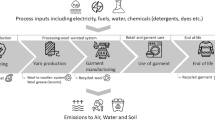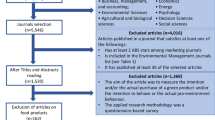Abstract
Purpose
In the process of developing Product Environmental Footprint Category Rules (PEFCR)—currently tested in various pilots in the Single Market for Green Products initiative of the European Commission—the definition of product category benchmarks and environmental performance classes is a crucial element of each PEFCR. Whilst life cycle assessment (LCA) methodology developed over the last 20 years can be used for many other topics to be tackled in the pilots, there is a clear lack of methodology for the determination of benchmarks and environmental performance classes. In this article, hence, we address this gap and develop a procedure for benchmarking and environmental performance classes in LCA.
Methods
To do this, given requirements and definitions of the PEF guidelines on both subjects are taken as a basis and are refined by using common LCA techniques like hot spot and sensitivity analyses. The specific steps of the procedure are applied systematically in a case study using sports shoes as an example.
Results and discussion
The resulting procedure involves the definition of a scenario vector, which is composed of relevant life cycle phases as well as the lifetime of the product (i.e. sports shoes) as variables. On the basis of the hot spot and sensitivity analyses, these variables are quantified, first, to generate the benchmark and, second, to determine the environmental performance classes around the benchmark for each considered impact category individually. In addition, the influence of data uncertainty on the class distribution is assessed with the help of the Monte Carlo simulation.
Conclusions
The results of the application in the case study demonstrate the high impact of the product’s lifetime on the final environmental performance classes, and the importance of data quality. Limitations are identified regarding data availability and the harmonisation of the classes to potentially create a PEF label. A debate is induced on the validity of such a label when considering the fact that the characterisation methods and factors proposed in the PEF guidelines may not be complete or accurate enough.





Similar content being viewed by others
Notes
For the case of sports shoes: There is no BREF document for apparel products available, but only for the materials used (see also Joint Research Centre 2015).
References
Centre for the Promotion of Imports from developing countries – CBI (2010) The EU market for sports footwear. CBI Market Information Database
Cheah L, Duque Ciceri N, Olivetti E et al (2013) Manufacturing-focused emissions reductions in footwear production. J Clean Prod 44:18–29
European Commission (2010a) Commission Delegated Regulation (EU) No 1060/2010 of 28 September 2010 supplementing Directive 2010/30/EU of the European Parliament and of the Council with regard to energy labelling of household refrigerating appliances. Off J Eur Union
European Commission (2010b) Regulation (EC) No 66/2010 of the European Parliament and of the Council of 25 November 2009 on the EU Ecolabel. Off J Eur Union
European Commission (2013) Commission Recommendation (2013/179/EU) of 9 April 2013 on the use of common methods to measure and communicate the life cycle environmental performance of products and organisations—annex II: product environmental footprint (PEF) guide. Off J Eur Union 54
European Commission (2014a) Single market for green products initiative. http://ec.europa.eu/environment/eussd/smgp/index.htm. Accessed 02 June 2014
European Commission (2014b) Environmental Footprint Pilot Guidance document. Guidance for the implementation of the EU Product Environmental Footprint (PEF) during the Environmental Footprint (EF) pilot phase, v. 4.0, May 2014
European Commission – Joint Research Centre (2011) International reference life cycle data system (ILCD) handbook—recommendations for life cycle impact assessment in the European context, 1st edn. Publications Office of the European Union, Luxemburg
Finkbeiner M (2014) Product environmental footprint—breakthrough or breakdown for policy implementation of life cycle assessment? Int J Life Cycle Assess 19(2):266–271
James K, Galatola M (2015) Screening and hotspot analysis: procedure to identify the hotspots and the most relevant contributions (in terms of, impact categories, life cycle stages, processes and flows). Version 4.0. European Commission
Joint Research Centre (2015) Reference documents. http://eippcb.jrc.ec.europa.eu/reference. Accessed June 02 2014
Kowalska M, Cordella M, Wolf O et al (2013) Background report—revision of Ecolabel for the product group “footwear”. Joint Research Centre, European Commission, Brussels
Lehmann A, Bach V, Berger M et al (2014) Applying PEF in practice—challenges related to the development of PEFCRs and benchmarks. SETAC Europe 24th Annual Meeting, 15 May 2014, Basel, Switzerland
Lehmann A, Bach V, Finkbeiner M (2015) Product environmental footprint in policy and market decisions: applicability and impact assessment. Integr Environ Assess Manag 11(3):417–424
Lo SC, Ma H, Lo SL (2005) Quantifying and reducing uncertainty in life cycle assessment using the Bayesian Monte Carlo method. Sci Total Environ 340:23–33
Nissinen A, Grönroos J, Heiskanen E et al (2007) Developing benchmarks for consumer-oriented life cycle assessment-based environmental information on products, services and consumption patterns. J Clean Prod 15:539–549
Sustainable Apparel Coalition – SAC (2014) Non-leather shoes: input to steering committee approval. Prepared by members of the SAC and PE INTERNATIONAL. Accessible from the Environmental Footprint wiki. Accessed 15 June 2014
Author information
Authors and Affiliations
Corresponding author
Additional information
Responsible editor: Walter Klöpffer
Sarah Gül and Michael Spielmann were formerly affiliated with thinkstep (former PE INTERNATIONAL).
Rights and permissions
About this article
Cite this article
Gül, S., Spielmann, M., Lehmann, A. et al. Benchmarking and environmental performance classes in life cycle assessment—development of a procedure for non-leather shoes in the context of the Product Environmental Footprint. Int J Life Cycle Assess 20, 1640–1648 (2015). https://doi.org/10.1007/s11367-015-0975-7
Received:
Accepted:
Published:
Issue Date:
DOI: https://doi.org/10.1007/s11367-015-0975-7




